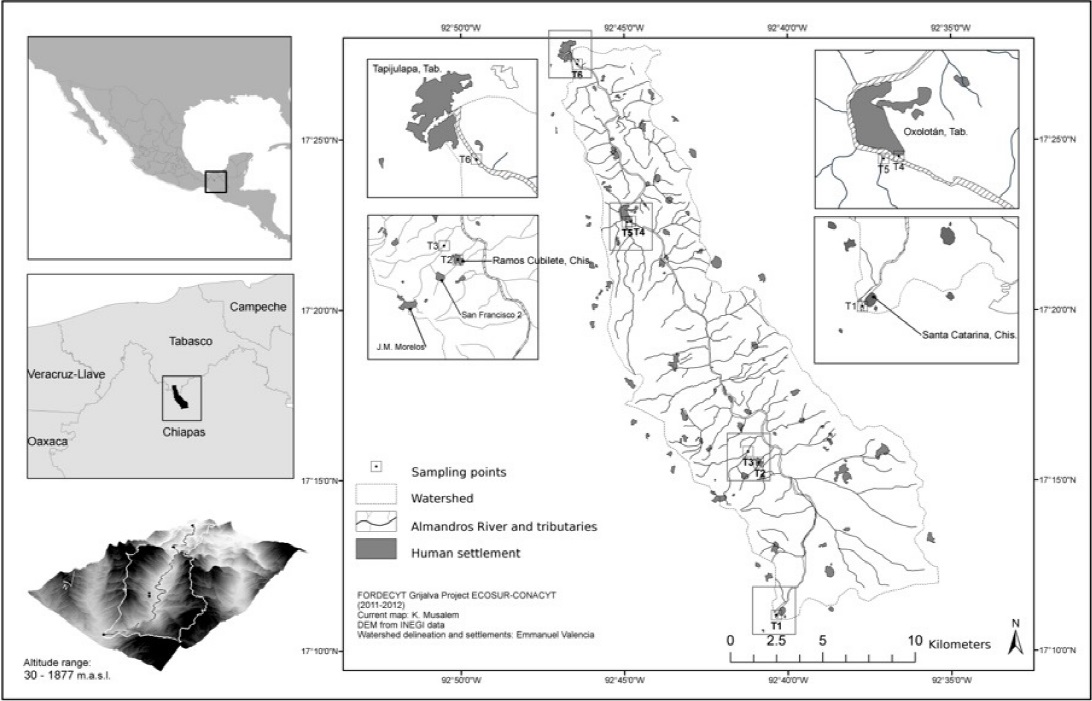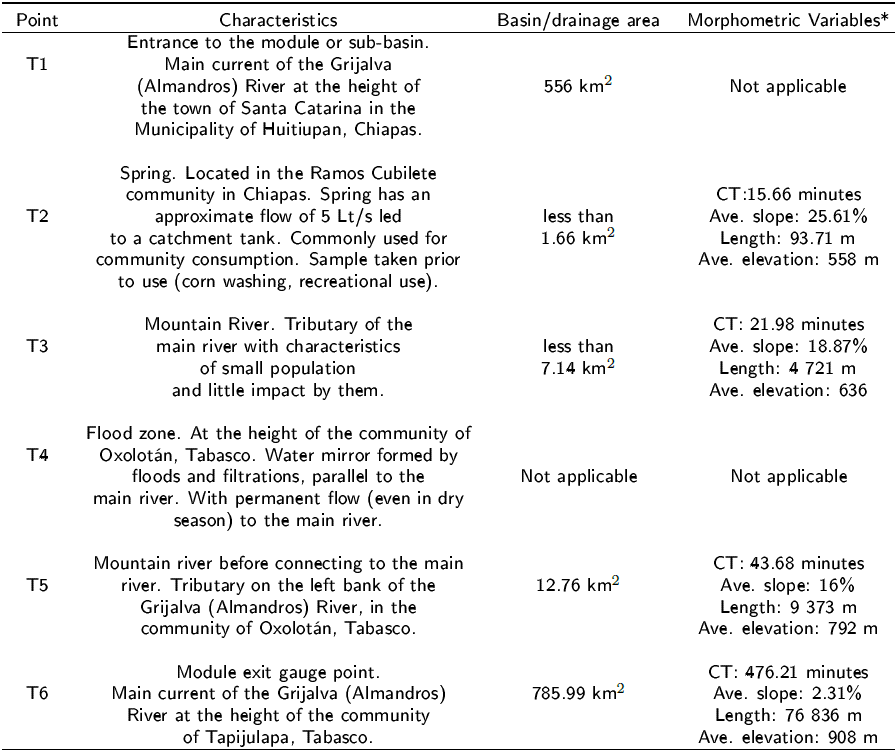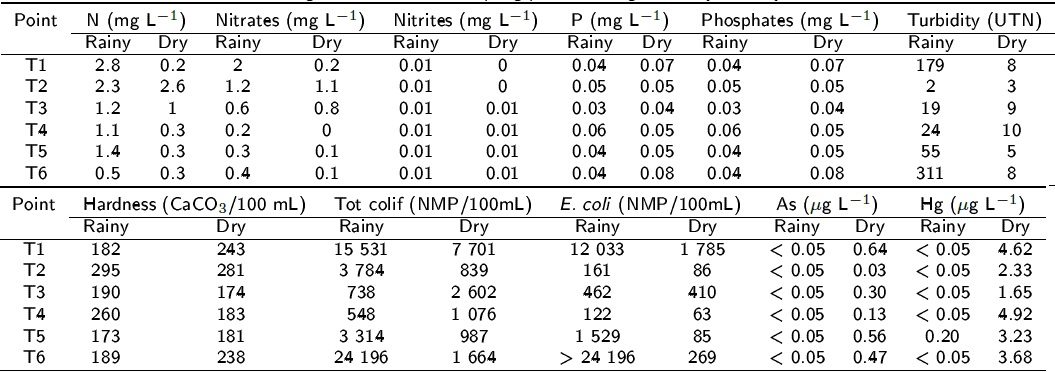INTRODUCTION
Water quality is directly related to the lives of rural populations, especially in places where the supply is directly from surface runoff or where communities depend on water resources for fishing and recreational activities. The quality of water is relevant to determine its use, as well as being a management and pollution indicator (Laino-Guanes et al. 2016, Yu et al. 2016). Water quality variables allow to have a vision of a specific moment, and serve as a baseline to observe the changes or trends in basins (Musalem et al. 2014). At the global level, basins are undergoing a decline in their water quality, due to their levels of sedimentation, salts and nutrients (Lintern et al. 2018).
About 35% of Mexico’s total freshwater flows through the Grijalva and Usumacinta rivers (CONAGUA 2011). Despite this, the rural communities settled along these rivers live in conditions of extreme poverty, with severe deterioration of natural resources and limited access to good quality water (González-Espinosa et al. 2014, Plascencia et al. 2014). The combination of several biophysical, social and environmental factors generates a high degree of vulnerability to disasters caused by events such as landslides and floods, and there is great interest in the region in mining, an activity that can cause irreversible damage to the environment (Laino-Guanes et al. 2015).
Several studies that analyze water quality in the Grijalva basin are concentrated in the lower part of the basin, in urban areas or in major rivers, where monitoring with greater frequency is more feasible, although commonly with few parameters studied (Borbolla-Sala, et al. 2003). On the other hand, there are few studies in the middle and upper parts of the basin. Water quality parameters reflect water characteristics that can have different effects on human health and on aquatic ecosystems, with varying degrees of danger (Ramos-Herrera et al. 2012). Concentrations outside the permissible ranges cause pollution (Kulinkina et al. 2016). Therefore, the present study was conducted to have a water quality baseline for a section of the Grijalva River and some of its tributaries, with the objective of obtaining local data on the water quality in tributaries used by the population for consumption and economic activities.
MATERIALS AND METHODS
Study area
The study was conducted in a section of the Grijalva River, locally known as the Almandros River (Valencia-Barrera 2014). The section is located on the border between Chiapas and Tabasco states, and is part of the Grijalva River drainage system. It has elevations ranging from 30 to 1,877 masl, with a catchment area of 56.6 km2. The study area belongs to the XI Frontera Sur and 30 Grijalva-Usumacinta regions (CONAGUA 2011). It is located in the middle basin of the Grijalva River and includes territories belonging to Huitiupán municipality in the State of Chiapas and Tacotalpa municipality in the State of Tabasco. The predominant vegetation type is medium-height evergreen forest, with different degrees of disturbance, ranging from areas completely deforested for livestock farming to forest fragments with trees over 25 m in height. The most represented species are Brosimum alicastrum, Cedrela odorata and Spondias mombin (Ramírez-Marcial et al. 2014).
Six sampling points were selected in this section of the Grijalva River, two on the main river, and four in springs and tributaries (Figure 1 and Table 1). The study area is geographically isolated, not communicated and in most of the roads there is no vehicular access.

Figura 1: Location of the sampling points on the Grijalva River and its tributaries. The watershed corresponds to the delimitation of the regional module of the Grijalva Basin Project with the Pfafstetter methodology.
Tabla 1: Collection points and description of the water current studied in the Grijalva River. Source: cuencas y variables morfométricas a través del SIATL (2012).

*Morphometric variables calculated by the Water Flow Simulator (SIATL) of the Instituto Nacional de Estadística y Geografía (INEGI). CT = concentration time, Ave. slope = average slope, Ave. elevation = average elevation.
Evaluated water quality variables
Twenty-three water quality variables were analyzed, in samples taken during the rainy season (August 2011) and dry season (January 2012). For the transfer of the samples to the laboratory, they were put in refrigeration from the moment they were taken at the points until arrival at the laboratory in less than 24 h. The variables evaluated were: dissolved oxygen (DO), pH, chemical oxygen demand (COD), biochemical oxygen demand (BOD), total nitrogen (N), nitrites, nitrates, total phosphorus (P), phosphates, total dissolved solids (TDS), total suspended solids (TSS), total hardness, turbidity, total coliforms and Escherichia coli. The content of As, Cd, Cr, Cu, Hg, Ni, Pb and Zn was also determined.
The DO and pH were measured in situ at the time of taking the water sample, the DO by chemiluminescent membrane electrodes (Jiménez-Cisneros 2001) and pH by the electrochemical or specific electrodes method (APHA 1998). In the laboratory, COD was determined by the spectrophotometric method (SE 2001c), BOD by the volumetric method (SE 2001a), total nitrogen by persulfate digestion HACH 10071, nitrites by means of cadmium reduction HACH 8039 adapted from the APHA method (1998), nitrates by diazotization HACH 8507 approved by the EPA and according to the standard NMX-AA-099-SCFI-2006 (SE 2006); total phosphorus, phosphates, TDS and TSS by the molybdate HACH 10127, stannous chloride and gravimetric methods, respectively (SE 2001b), total hardness by the volumetric technique by acid-base titration, turbidity by the nephelometric method, total coliforms and Escherichia coli by the microbiological method of the most probable number (SCFI 1987).
Heavy metal analysis
The determination of the content of heavy metals was carried out in accordance with Official Mexican Standard NMX-AA-O51-SCF1-2001 (SE 2001e). The determination of chromium (Cr), copper (Cu), nickel (Ni), lead (Pb) and zinc (Zn) content was carried out by atomic absorption spectrophotometry, in a VARIAN SpectrAA220 model spectrometer. The limits of quantification for Cu, Cr and Ni were 200 μg L-1; for Pb, 190 μg L-1, and for Zn, 340 μg L-1. For quality control, WasteWateRTM Trace Metals certified reference material, triplicate sample analysis and reagent blank analysis were used.
The determination of the arsenic (As), cadmium (Cd) and mercury (Hg) content was carried out in a GBC AVANTA PM atomic absorption spectrophotometer, with flame and a GBC HG 3 000 model hydride generator. The samples were digested in a Lanconco semi-micro Kjeldahl digester. The limits of quantification of these analyzes for As and Hg were 0.05 μg L-1, and for Cd, 0.4 μg L-1. Four treatment blanks and a triplicate for quality control were analyzed for each element, in addition to triplicate analysis of certified reference material. The determination was made according to ET-QU03 procedures (EAA 2008).
Maximum permissible limits and comparative analysis of means
The water quality results were compared with the maximum permissible limits (MPLs) of Official Mexican Standard NOM-127-SSA1-1994 (SS 1994). The COD and BOD results were analyzed with the CONAGUA water quality classification scale (SEMARNAT 2015). To find out whether there are differences between the seasons in which the water samples were taken, Tukey’s range test (p ≤ 0.05) was performed with INFOSTAT software (Di Rienzo et al. 2015).
RESULTS
Dissolved oxygen (DO) and pH
In the dry season, the highest DO values were found at all sampling points, except for the spring sample (T2) that showed the highest DO in the rainy season (Table 2). In general, the flood zone (T4) had the highest DO concentrations (12.9 mg L-1), while the spring had the lowest DO contents (5.5 mg L-1). By sampling season, the rainy season had the lowest pH (Table 3), but in both sampling periods the pH was within the MPLs indicated in the Official Mexican Standard.
Tabla 2: Concentrations of dissolved oxygen (DO), pH, total dissolved solids (TDS), total suspended solids (TSS), chemical oxygen demand (COD) and biochemical oxygen demand (BOD) at sampling points during the rainy and dry seasons.

NA = sample not analyzed.
Total dissolved solids (TDS) and total suspended solids (TSS)
The TDS values detected at the sampling points, in the two seasons of the year, do not exceed the MPLs of the Official Mexican Standard (Table 2). In the dry season, higher TDS contents were detected, except for point T4. The highest TDS content was found in the spring (T2, 680 mg L-1) and the lowest in the mountain river (T5, 380 mg L-1). For the TSS content, the highest values were found in the rainy season, and the highest levels were found at the entry points to the module or sub-basin (T1) and the outflow of the module or sub-basin (T6) with 186 mg L-1 and 304 mg L-1, respectively, while the lowest concentrations were in the spring (T2) and the mountain river before its connection to the main river (T5), with 1 mg L-1 at both points.
Chemical oxygen demand (COD) and biochemical oxygen demand (BOD)
At all sampling points the COD and BOD values were higher in the rainy season (Table 3), with the water quality in the dry season being adequate at all sampling points for COD and BOD. In the rainy season, water quality varies from excellent to acceptable, although the outlet of the module or sub-basin (T6) has water with high COD values. For BOD, in the rainy season the water quality varies between good and acceptable.
Mineral content
The highest nitrogen concentrations were found in the rainy season, with the exception of the spring (T2), which had the highest nitrogen content during the dry season (Table 3). The concentrations of nitrates and nitrites at all sampling points, in both seasons of the year, do not exceed the MPLs established in the Official Mexican Standard, with the highest nitrate contents occurring in the rainy season.
P and phosphate concentrations lower than 0.1 mg L-1 were found at all sampling points and at both times of the year.
Turbidity and hardness
Turbidity values are higher in the rainy season at all sampling points, except for the spring (T2), where turbidity values did not exceed the MPLs established by the Official Mexican Standard of 5 UTN. The highest values were found at the entrance to the module or sub-basin (T1) and at the module exit gauge point (T6) in the rainy season, with 179 UTN and 311 UTN, respectively. The hardness values found at all sampling points and in both seasons of the year did not surpass the MPLs of the Official Mexican Standard (Table 3).
Total coliforms and Escherichia coli
The presence of total coliforms and E. coli was detected at all sampling points in both sampling seasons. For total coliforms, the values found in both sampling periods exceeded the MPLs of the Official Mexican Standard, with the values found in the rainy season being higher. The highest coliform values were found at the entrance to the module or sub-basin (T1) and at the module exit gauge point (T6) with values of 15 531 NMP 100 m L-1 and 24 196 NMP 100 m L-1, respectively. For E. coli, the highest concentrations were found in the dry season at all sampling points (Table 3), with the highest bacterial concentrations found at points T1 and T6.
Heavy metal content
The presence of arsenic (As) was detected at all sampling points during the rainy season (Table 3), but does not exceed the MPLs indicated in the Official Mexican Standard, while mercury (Hg) was detected in the dry season at all sampling points, and in the rainy season it was detected only at the mouth of the mountain river (T5). Both elements had their highest values in the dry season, with statistical differences between sampling periods. The values found at all sampling points in the dry season surpassed the MPLs indicated in the Official Mexican Standard. No presence of Cd, Cr, Cu, Ni, Pb or Zn was detected.
DISCUSSION
The presence of Hg and As was detected in the dry season, with Hg presenting higher values than the MPLs indicated in Official Mexican Standard NMX-AA-O51-SCF1-2001 (SE 2001e). Laino-Guanes et al. (2015) have reported similar As and Hg values in the upper part of the Grijalva River basin, while Alvarado-Arcia et al. (2015) report the presence of Cd in soils and sediments of the Grijalva River’s main channel. Hg is one of the ten most dangerous contaminants to public health, so studies on its bioavailability and effects on humans are justified (Bjørklund et al. 2017). Despite the above, there is still scarce literature for this basin and Mexico in general; in this regard, Leal-Ascencio et al. (2009) highlight the lack of standards for metals in Mexico. The Hg data obtained in this study range from 1.65 to 4.92 ug L-1 in the dry season, which is above the range reported by Guentzel et al. (2017) for a lagoon system in the Papaloapan River Basin, while Guentzel et al. (2017) found that Hg concentrations correlated with higher TSS values. The presence of Hg can originate from natural or anthropogenic sources, with the possible causes including volcanic activity, forest fires, erosion of rocks, mining, crematoria and wastewater discharges (Pirrone et al. 2010, Laino-Guanes et al. 2015).
No presence of Cd, Cr, Cu, Ni, Pb or Zn was detected. These results coincide with those of Laino-Guanes et al. (2015) who found concentrations below the MPLs for these minerals in the upper basin of the Grijalva River. However, Leal-Ascencio et al. (2009) report for the El Limón lagoon, in the Grijalva River basin, Zn, Ni, Cr, Cd and Cu contents higher than the MPLs, a situation that could be attributed to the accumulation of metal content in the lagoons due to the sedimentation typical of lagoon systems (Bryan and Langston 1992). The BOD values of 4 to 18.5 mg L-1 in the rainy season and from 1.9 to 2.4 mg L-1 in the dry season, and the average COD values of 27.6 mg L-1 in the dry season and of 3.06 mg L-1 in the rainy season found in the present study are within the values reported by Ramos-Herrera et al. (2012) for the Almandros River. For the TSS content, values between 1 and 6 mg L-1 were found in the dry season, while in the rainy season the values were between 2 and 304 mg L-1; in this regard, Ramos-Herrera et al. (2012) report an average value of 102.3 mg L-1 and Laino-Guanes et al. (2016) values between 1.8 and 4.3 mg L-1 for the dry season, while in the rainy season the values ranged between 31.1 and 548.8 mg L-1.
The concentrations of total coliforms and E. coli exceeded the permissible values at all sampling points in the two sampling periods, which coincides with the reports of microbiological contamination in excess of the MPLs of the Official Mexican Standard at different points in the Grijalva basin, mainly in rivers associated with urban areas (Castañon and Abraján 2009, Laino-Guanes et al. 2016) and even in drinking water supply systems in both cities and rural communities (Sánchez-Pérez et al. 2000, Galdos-Balzategui, A. et al. 2017).
CONCLUSIONS
The presence of Mercury and Arsenic was greater in the dry season. Although some other parameters indicate better water quality in the dry season, such as the TSS and COD content, there were no differences between sampling periods. The concentrations of total coliforms and E. coli exceeded the permissible values at all sampling points in the two sampling seasons.











 nueva página del texto (beta)
nueva página del texto (beta)



